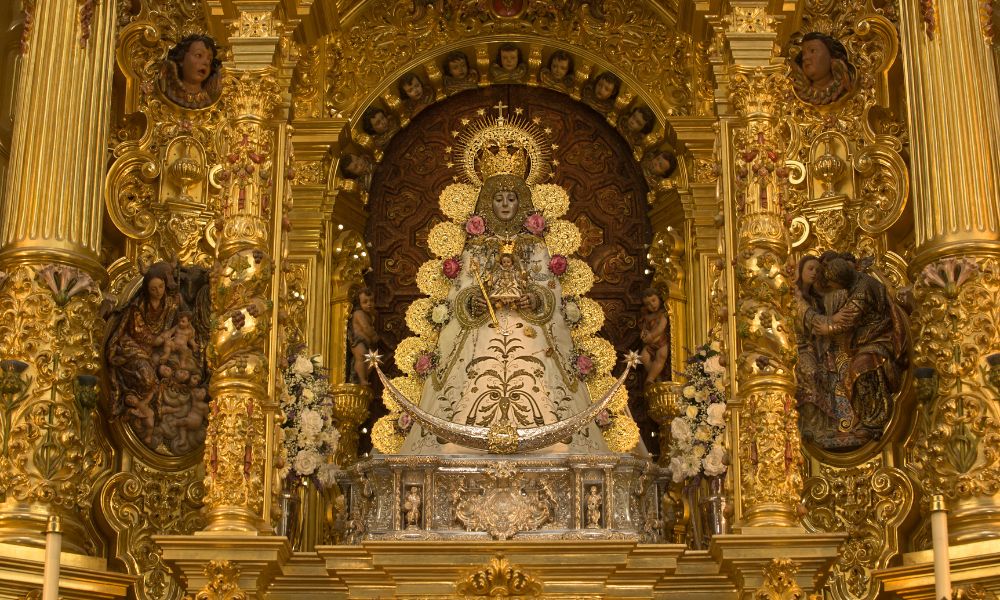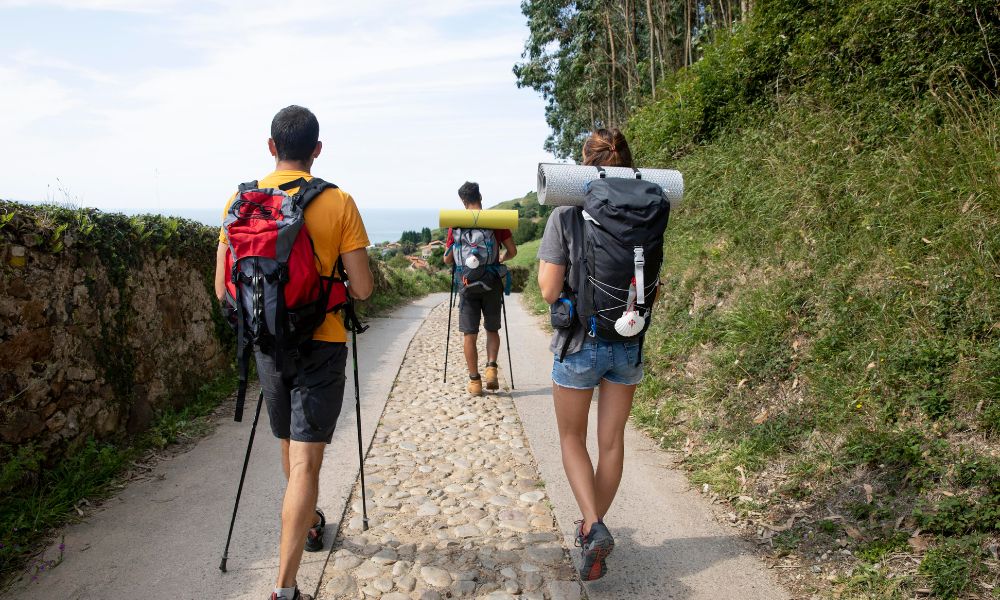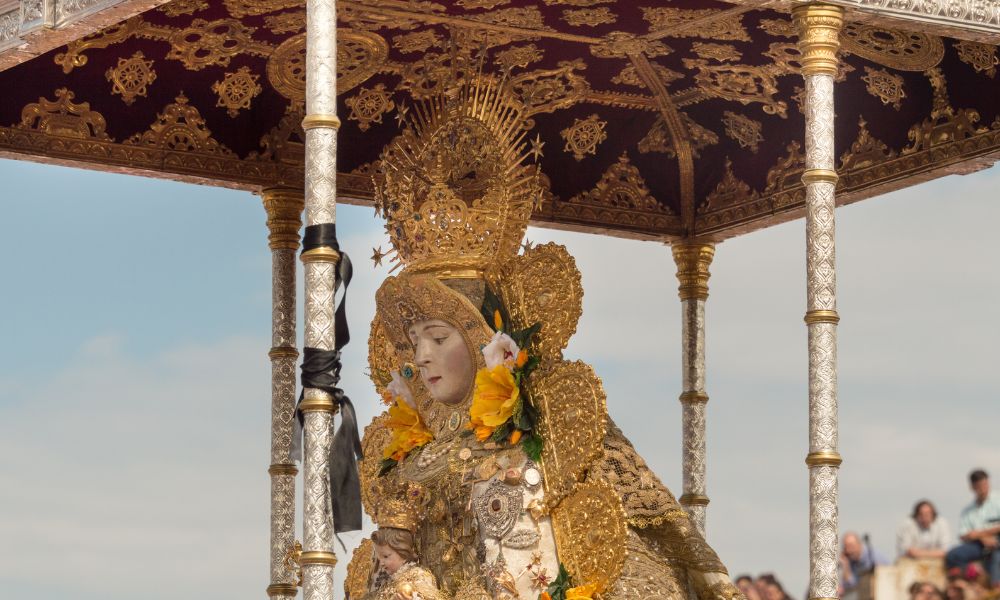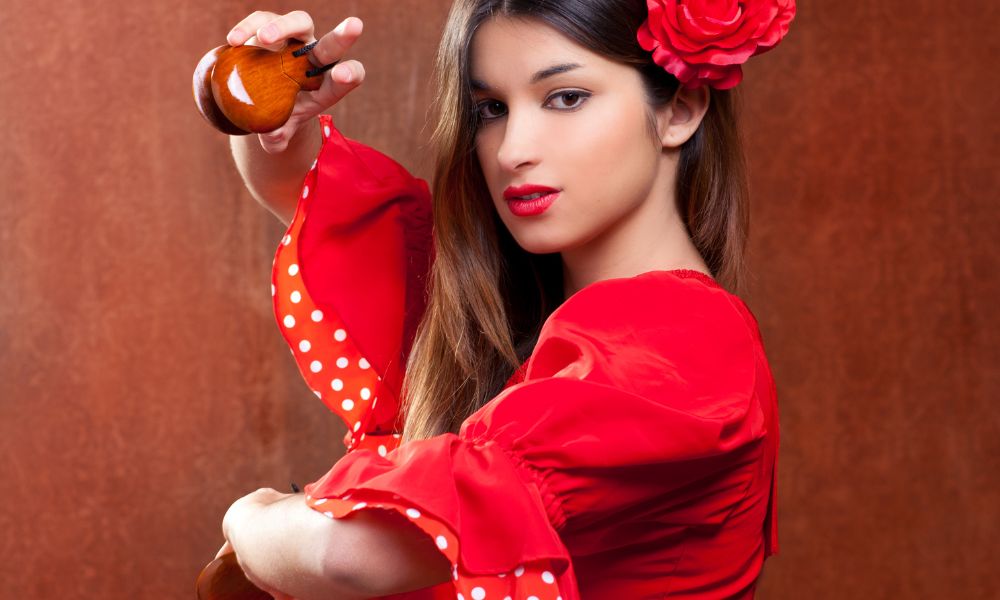In the heart of Andalusia, one of the most emblematic and exciting pilgrimages in Spain unfolds: the Romería del Rocío. This event reflects religious devotion and serves as a vibrant testimony to the rich Andalusian tradition. In this guide, we will explore the uniqueness of this pilgrimage, immersing ourselves in a festivity where spirituality, folklore, and community intertwine.
Every year, thousands of pilgrims make their way to the village of El Rocío in Almonte (Huelva), driven by deep faith and a cultural heritage passed down through generations. This pilgrimage is much more than a religious manifestation; it is a gathering point for family and friends and a spectacle of traditional costumes.
First, it is essential to understand its historical and cultural context, which is framed within the most significant pilgrimages in Spain. This event is not only an expression of faith but also a mirror of the traditions and history of the region.
Next, you will learn about the origins and evolution of this festival, as well as the devotion to the Virgin of El Rocío and the influence of Andalusian culture on it.
The history of devotion to the Virgin of El Rocío dates back to the early 15th century. Legend suggests that the image was miraculously discovered by a hunter in Doñana Park.
Since then, this image has been the subject of a cult that has grown exponentially, especially since the 17th century when the brotherhood that guards the Virgin was officially established. Over the centuries, the pilgrimage has witnessed how generations of devotees have kept the flame of this tradition alive, renewing their spiritual commitment year after year.

Several legends surround the figure of the Virgin of El Rocío, each adding layers of meaning to her devotion. One of the most popular stories tells how the Virgin appeared to a shepherd, guiding him to her image hidden in the trunk of a tree.
These types of narratives have enriched Andalusian popular culture, endowing the pilgrimage with an aura of mysticism and miracle that attracts devotees not only because of their faith but also due to the charm of these stories.
For many devotees, she is more than a religious figure; she is a symbol of protection, hope, and community. The “Mother of the Marshes,” as she is also known, is venerated for her ability to unite people in a spirit of peace and solidarity.
The Romería del Rocío is not just a religious event; it is also an expression of Andalusian culture. During the pilgrimage, it is common to see pilgrims sharing deep emotions and personal experiences of faith, attributed to the intercession of the Virgin.
The devotion transcends the individual and manifests in a collective filled with fervor. This devotion has allowed the Romería del Rocío to remain one of the deepest manifestations of Marian faith in Spain. Each pilgrimage is a living testimony to the continuity and evolution of Christian spirituality in Andalusia.
This pilgrimage is comparable in fervor and devotion to sacred sites such as the Virgin of Lourdes in France, the Guadalupe in Mexico, and Medjugorje in Bosnia-Herzegovina. Every year, this event attracts hundreds of thousands of people who come together in a journey of faith, tradition, and community.
This is a manifestation of faith and a large-scale sociocultural event that includes a wide range of activities.
The pilgrims, known as rocieros, embark on a journey to the sanctuary of the Virgin of El Rocío in Almonte, Huelva, traveling along paths that cross the Doñana National Park. This journey is undertaken on foot, on horseback, or in traditionally adorned carts, creating a spectacle of color and devotion.
During the pilgrimage, participants engage in a series of religious and recreational activities. Masses and processions are intertwined with flamenco singing and dancing, shared meals, and nights of fellowship around the fire.
It is this combination of spirituality and festivity that gives the Romería del Rocío its unique character, making it an unforgettable experience for all who participate.
The Brotherhoods of El Rocío play a vital role in the organization and development of the pilgrimage. These associations, which can be compared to confraternities, are spread throughout Spain, and each has its own history, traditions, and distinctive attire.
They are responsible for coordinating the preparations for the journey, managing the itineraries of the carts, and ensuring that everything is carried out in accordance with the rules of the pilgrimage and respect for the Virgin.
These brotherhoods not only handle the logistical aspects but also foster a sense of community and spirituality among their members. Their commitment is a testament to their dedication to keeping this tradition alive, passing on its meaning and relevance from generation to generation.
Loyalty and love for the Virgin of El Rocío and the pilgrimage are reflected in every step of the journey, strengthening the bonds of brotherhood and devotion among the rocieros.

The journey to El Rocío is both physical and spiritual, marked by a series of traditional routes that each brotherhood follows depending on their origin.
Among the most famous routes are:
These paths are physical routes that represent personal and collective transformation. Here, pilgrims share experiences, songs, prayers, and moments of silence, creating an atmosphere of deep introspection and spiritual connection.
The difficulty of the journey and exposure to the elements add a dimension of sacrifice and offering to the experience. In the end, the arrival at the sanctuary of the Virgin of El Rocío is a moment of immense emotion and gratitude.
The Virgin of El Rocío, known for her tenderness and closeness to the faithful, holds a special place in the religious tradition of Andalusia and, by extension, Spain. Her devotion is comparable to that observed at other renowned Marian shrines, such as the Sanctuary of Fatima.
Below, we mention the historical accounts and miracles attributed to the Virgin, her artistic representation, and the festivities that celebrate her presence in the community.
According to tradition, the Virgin appeared to a hunter in the 15th century, guiding him to her image hidden in the trunk of a tree in the marshes. Since then, numerous miracles have been attributed to her intercession, strengthening the faith of her devotees and consolidating her status as a pilgrimage center.
These miracles range from inexplicable healings to protection during natural disasters, reflecting the perception of this figure as a protective and compassionate mother. Each testimony and miracle adds layers of meaning to the cult of the Virgin of El Rocío, attracting more pilgrims each year, eager to experience her grace and seek her guidance in times of need.
Her image is a masterpiece of religious art, rich in symbolism and beauty. Often depicted with the Child Jesus in her arms, she is seen as a symbol of motherhood and protection. Her iconography is typically adorned with a starry mantle, symbolizing her role as “Queen of Heaven,” and surrounded by motifs that evoke purity and holiness, such as doves or rays of light.
Of course, the most notable of these events is the Romería del Rocío, celebrated during Pentecost weekend. During this time, the village of El Rocío transforms into a place of festivity and worship, with thousands of pilgrims arriving to pay homage to the Virgin.
In addition to the pilgrimage, there are other festivals and ceremonies throughout the year that allow the faithful to express their devotion and maintain their connection with the Virgin. These celebrations include novenas, special masses, and community events that strengthen the bonds between brotherhood members and the community in general.

The Village of El Rocío is much more than a pilgrimage destination. It is a symbol of Marian devotion and a time capsule that preserves Andalusian traditions and culture.
The village of El Rocío has served as the nerve center of the pilgrimage in honor of the Virgin of El Rocío for centuries.
Its origin is closely linked to the legend of the Virgin’s apparition in the 15th century, after which the locality began to gain recognition as a sacred place. Over time, it has developed around its famous hermitage, growing in size and structure to accommodate the thousands of devotees who visit it each year.
This place has evolved from a small settlement into a village with an infrastructure capable of supporting large-scale events like the annual pilgrimage. This growth has been driven both by the need to host an increasing number of pilgrims and by the desire to preserve the sacred and traditional character of the place.
Today, the village is not only a spiritual destination but also a cultural meeting point where Andalusian traditions are celebrated with great fervor.
This is a building of considerable historical and architectural importance that houses the revered image of the Virgin of El Rocío. The current structure is the result of several reconstructions and restorations over the centuries, adapting to the community’s needs and the challenges of time.
The significance of the hermitage transcends its architecture; it is a symbol of refuge and hope for the faithful. During the pilgrimage, it becomes the epicenter of religious activities, hosting masses, vigils, and the iconic procession of the Virgin.
The village of El Rocío has developed impressive infrastructure. This includes numerous brotherhood houses, which provide lodging and basic services to members during their stay. These facilities are essential for the logistics of the pilgrimage, offering everything from dormitories to dining halls and spaces for the celebration of rites and meetings.
In addition to the brotherhood houses, the village has hostels, hotels, and temporary camps set up specifically for the pilgrimage. These lodging options allow pilgrims from all over the world to participate in the event, ensuring they can fully experience the Romería del Rocío with comfort and safety.
This gathering is a compendium of experiences and rituals that encapsulate both religious devotion and the rich Andalusian culture. From moments of intense spirituality to joyful expressions of folklore, every aspect of the pilgrimage helps create an unforgettable atmosphere.

The Salto de la Reja is perhaps the most exciting and anticipated moment of the Romería del Rocío. This event takes place in the early hours of Pentecost Monday. On this day, the people of Almonte, dressed in their traditional outfits, jump over the rail that protects the altar of the Virgin of El Rocío to carry her image in procession.
This act symbolizes the liberation of the Virgin from her sanctuary so that she can be closer to her devotees, marking the beginning of one of the most emotional and spectacular processions of the pilgrimage.
The Salto de la Reja is an expression of Almonte’s cultural identity. The anticipation builds for hours as the pilgrims sing and pray, waiting for the moment. When it finally happens, the air is filled with jubilation and fervor, with intense emotions felt throughout the crowd, reflecting the deep connection the devotees feel with their patron saint.

Music and dance are essential components of this event, filling the atmosphere with the joy and spirit of Andalusia.
Traditional songs and dances, such as sevillanas and fandangos, are eagerly anticipated practices for all participants. These folkloric expressions provide entertainment and are ways to express devotion and love for the Virgin, reinforcing the sense of community and belonging among the pilgrims.
During the pilgrimage, it is common to see groups of all ages singing and dancing in the village streets, around bonfires, or in the brotherhood houses. This music, accompanied by guitars and handclaps, creates a link between the past and present, allowing traditions to be passed down from generation to generation.
Religious practices are at the heart of the Romería del Rocío, and they manifest through a series of rituals filled with symbolism and spirituality.
The processions, prayers, and vigils take place throughout the pilgrimage, providing moments of introspection and communion with the divine. These practices are not only times for prayer and petition but also for thanksgiving and spiritual renewal.
One of the most moving rituals is the procession of the Virgin through the village, where the faithful have the opportunity to show their love and respect for the Virgin of El Rocío. This procession allows devotees to feel physically close to this figure, reaffirming their faith and receiving comfort and blessings.
Additionally, the reflection and silence during the night vigils contrast with the day’s bustle, offering space for personal reflection and intimate encounters with the spirituality of the event.
Participating in the Romería del Rocío is a deeply spiritual and culturally enriching experience. However, to make the most of this experience and ensure it is as safe and rewarding as possible, good preparation is crucial.
Planning is essential when it comes to taking part in this type of pilgrimage, especially given the large number of pilgrims and the unique nature of the event.
Interested individuals should start by finding out the exact dates of the pilgrimage, which usually coincides with Pentecost weekend. It is advisable to register with one of the pilgrim brotherhoods, as this can provide access to resources and guides that will enhance the experience.
Additionally, it is important to properly prepare the pilgrimage equipment. This includes suitable clothing for long walks, protection from the sun and rain, and enough water and food for the days of travel. Likewise, pilgrims should consider bringing religious items such as rosaries, images of the Virgin, and prayer books to enrich their spiritual experience.
Since the Romería del Rocío attracts hundreds of thousands of visitors, it is important to book accommodation in advance. Options include brotherhood houses, hotels, hostels, and camping areas set up for the occasion.
As for transportation, many choose to make the journey on foot or horseback following tradition. For those seeking comfort or dealing with physical limitations, there are bus services and other motorized means available.
It is also essential to familiarize yourself with the local rules and traditions of the pilgrimage for harmonious coexistence with other pilgrims and the residents of El Rocío. This includes respecting prayer spaces, following the routes established by the brotherhoods, and participating in events and rituals with due respect and decorum.
Similarly, safety is a priority at an event of this magnitude. Pilgrims should be prepared for large crowds and long hours outdoors, which can involve risks such as dehydration, heat stroke, and fatigue. It is vital to bring a first-aid kit, stay hydrated and protected from the sun, and follow the instructions of organizers and local authorities.
Stay Connected with WayHoly
Discover your perfect pilgrimage and be the first to know about new journeys. By subscribing to our newsletter, you’ll receive the latest updates on pilgrimages, exclusive offers, and spiritual resources to enrich your faith journey.
Don’t miss the opportunity to deepen your connection with God and lead others on their path to spiritual renewal. Join us today and become an instrument of His Will through WayHoly!
“To upload your pilgrimage, please choose one of our plans and create an account, or log in if you’re already a member. Join us in guiding others on their spiritual journey.”